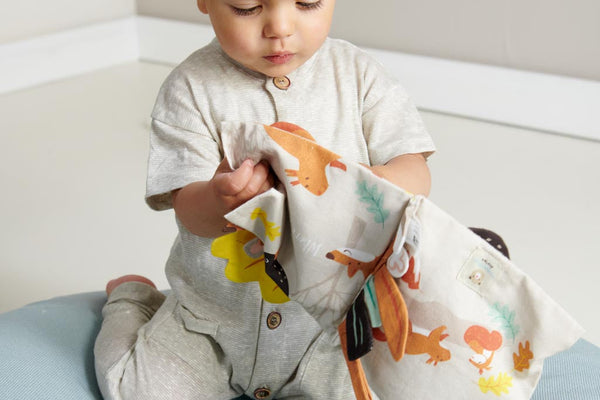Gift Guide | Toys for Babies

The world is a jumble of sights and sounds to a newborn. They see in black and white and, astoundingly, the senses are not yet fully connected.
Recent research into synaesthesia has shown that babies ‘hear’ colour and ’taste’ sound. The neural pathways that direct and organise information have not yet been pruned. Some connections are wrong. And so the senses get mixed up.
Over time, the correct pathways are reinforced and the senses separate fully.
What does this mean for your newborn?
Like will all later learning, you have to help your child make connections.
Here is a cow. It goes moo!
Here is a drum. Listen! Pa rum pum pum pum!
Here is a ball. Watch it roll.
Here is my hand. Feel my touch.
By playing with your child you help her to identify objects and events and so she learns to separate the senses. This is a sight, this is a sound.
You give her the vocabulary to label what she encounters. Dog, box, shoe, Mummy.

Rag books
This is why first books are so important.
Babies can’t read, of course, but they can share an experience with you. You point to a picture. They follow your finger. _Here is a dog_, you say. ‘Dog’, your child thinks, and associates the picture with the word. She is learning that everything has a name, a label. And that you can direct people’s attention to a thing by pointing or saying its name.
Your child is making connections.
It’s the foundation of all learning.
So rag books aren’t about reading. They are about sharing and about a common point of reference. Here are some things. They have names. And every time we look at this book the pictures and the names stay the same.
It’s a very powerful concept.
Babies learn other things from books, too.

Reading is a challenging gross motor activity for the youngest children. They want to reach out and touch the crinkly page and the scratchy flap. They want to turn the page and see what comes next. This is demanding and the work of many months.
Children also learn that each page has something new but that the pages are connected. When read in order, they tell a story, cementing the idea that there is a sequence to events.
Moreover, babies discover that stories are unchanging. The words and pictures are in exactly the same order every time.
First books also set your child on the road to independent play. Part of a baby’s first year is about learning to separate from parents and sit alone for a while. First books provide a great distraction, something to become absorbed in whilst apart.
Talk to your child about the book. Use the right vocabulary. Front, back, next, page.
The exact book you choose isn't especially important. What matters most at this stage is spending time with your child looking at the book together, talking about what happens when you read. Starting with the cover, give the book's title and talk about how it relates to the picture.
Look at this book. This is Dear Zoo. This is a lion. The lion goes rraaar! Can you see the lion? What does the lion say?
Go through each page doing the same, using your finger to show how the sounds you are making relate to what you are pointing at, demonstrating how the story or sequence always moves from left to right. Put the time in now and you’ll find they are reading them back to you sooner than you think!

Soft toys and rag dolls
What's the first toy everyone buys for a new baby? A soft toy, of course. But why?
These cuddly friends are a constant companion for young children but their play value doesn't become apparent for many years. A six-month-old won't do much more than hold on to - or bite - her doll. A toddler may hold tight for comfort during unhappy moments.
But the real magic happens once children reach the preschool years. The soft toy is now a co-conspirator, an accomplice on secret missions and the first guest on the list at the teddy bears' tea party. Children's developing understanding has taken them, via symbolic play, to the limitless, fairytale lands of the imagination.





